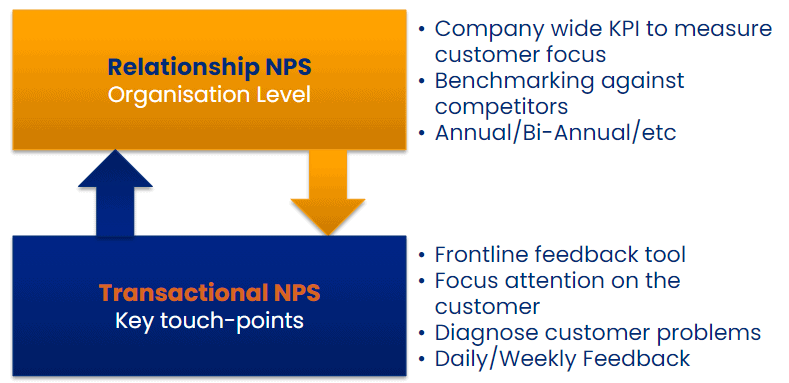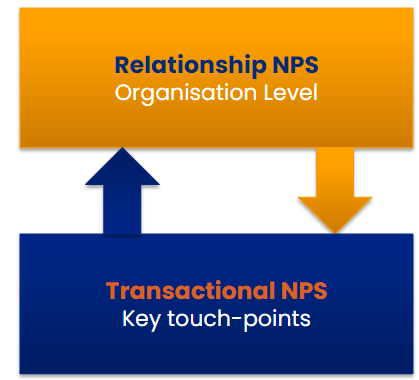From the first day of primary (or grade) school most of us compete.
I bet I can beat you to the fence/jump higher than you/hold my breath longer than you.
It doesn’t matter what the event; we’re ready to see who wins.
If you’re a CEO, or you report to one, and want to tell the outside world that that your company is the best, you might choose to compare Relationship NPS®. Unfortunately that may be as useful as it at first seems.
When running a Net Promoter® or customer feedback process, every organisation has the opportunity to perform the survey process in one or both of two ways:
- Transactional
- Relationship
Each approach has pros and cons so deciding which one is best for your organisation can be difficult.

What is Transactional Feedback?
Transactional customer feedback is generated when you survey the customer after each interaction or transaction with your organisation.
Typically this will be at one or more of your customer touch points and can include:
- order entry,
- product delivery,
- website interaction,
- account payment,
- sales contact,
- visit by a service technician, etc.
Normally in this approach you will directly reference the transaction in the survey question. e.g.
Based on your recent product delivery, how likely are you to recommend us to a friend or colleague on a scale of 0 to 10?
What is Relationship Feedback?
In contrast, Relationship customer feedback surveys occur at regular intervals in the customer relationship and ask about the customer’s overall satisfaction with the organisation.
For instance
How likely are you to recommend us to a colleague or client on a scale of 0 to 10?
What is the Difference Between Relationship and Transactional Feedback
There are two key differences:
Timing
Transactional (or Bottom-up) surveys occur shortly after a customer has interacted with your organisation. This could be completing a sale, receiving an invoice, contact a service centre, etc.
On the other hand, Relationship (or top down) surveys occur on a regular timeframe: say monthly, quarterly or annually.
Content
Transactional surveys are very short; often just 2 or 3 questions. They rely on a high number of responses and lots of qualitative data in order to be successful.
Relationship surveys are longer (20 or more questions) and rely on getting more information from each customer to be successful.
Neither approach is right or wrong and both have their advantages.
Pros and Cons of Transactional Feedback
Pros
Measures the points at with a customer’s perception changes
Generally a customer’s perception of your company will not change as they are merrily walking down the street. It is much more likely that their opinion of you will change when they are interacting with your organisation: speaking with a contact centre, reading an invoice, using a product, etc.
If you survey them shortly after that interaction then you are much more likely to get a good understanding of exactly what drove that change in sentiment and thus how to leverage the opportunity or fix the issue at the touchpoint.
Actionable
Because transactional feedback carries with it rich information on the transaction itself and detailed feedback from the customer, you are often able to directly link an issue with an action to resolve it.
NOTE: when you run a transactional feedback process the survey “meta-data” analysed should include a wealth of transaction information such as product line, location, transaction value, person with whom they interacted, customer segment, etc.
That combination of data (customer response and transaction details) makes transactional feedback a rich vein of relevant data in which to mine for actionable customer insights.
Initiate Service Recovery
Service recovery can be easily and effectively initiated from transactional feedback. Once again there are specific actions that the company can undertake based on the feedback they receive. If a customer has a problem with a product or delivery it is clear how to take action to recover the situation.
In addition, the Service Recovery paradox can be leveraged to immediately drive up customer loyalty.
Drives cultural change
Transactional feedback creates an ongoing stream of customer data that is difficult to ignore.
In addition, when you publicly display that stream of feedback you generate an intense organisational focus on the customer that can be difficult to replicate in any other way.
Service recovery stories can be particularly impactful because they are generated from the front line and tell how “we really are focusing on the customer”.
If you want to see how powerful this can be check out this video from CCH Asia Pacific.
Skip through to the 2:31min mark to hear the CEO of this company tell how he personally contacted a customer and performed service recovery. This is a very strong customer focus message directly from the organisation’s leadership.
By the way after you’ve seen the CEO section wind the video back to the start and see the whole video for a great example of how to engage employees in your Net Promoter program.
The diagnostic for determining where to focus
You probably have 10 or 15 customer touch points in your business but where should you spend your time and effort for maximum impact?
Which is the most important touch points on which to focus?
By aligning your feedback process to your customer journey you can measure which touch points are performing and which are letting you down. Now you have a customer satisfaction or NPS rating for each touch point you can do a simple Pareto analysis; find the lowest rated touch point and focus on improving that. When that improves move on to the next lowest score. Rinse and repeat.
Great for front line coaching
Providing front line staff with understandable and actionable feedback on what they are doing well and what they are doing poorly is critical for their ability to improve and provide the best customer experience.
Because you have included the front line persons details with the feedback you can report on the customer feedback for individual transactions by staff member.
If you have access to call recordings or other similar data, the ability for the front line employee to see how their actions relate to the customer’s feedback is a very powerful coaching tool.
NOTE: With great knowledge comes great responsibility — it is possible to misuse this information and treat it as a stick rather than a coaching device. You need to ensure that your team leaders have been coached themselves with the positive way to use this information not the negative ways.
Census based data collection
Typically when you gather customer feedback you work on a sampling system.
You might survey 5% of your customers every 6 months. While that is a good start, transactional surveys allow you to use a census approach and survey all of your customers. This greatly increases the volume of feedback that you will receive, increasing validity and the ability to extract useful customer insights.
As a corollary to the point above, because you are surveying all of your customers you can dramatically reduce the number of questions you ask each customer. This reduces the length of the survey, increasing response rates and reducing the impact on your customers.
Cons of Transactional Feedback
You will need automation
Without an automated customer feedback and reporting system the sheer number of moving parts in a transactional feedback process becomes very difficult to manage.
Daily uploads of data, sending surveys, collating responses, reporting, etc. all become complex and time consuming if you do not have an automated way to run the process.
Difficult to compare with other companies
While the feedback you receive is very actionable, it is difficult to compare or benchmark your scores with other organisations.
This is partly because you are surveying touch point interactions, which may be different to other organisation, and partly because your overall survey process may be very different to other organisations.
Need to make sure that you don’t over survey
With an automated system set up the tendency can be to survey every customer at all touch points. This is generally not a good idea as it can lead to the situation where you survey the same customer several times in a short time period.
To avoid this issue you need to implement hold-out periods. Perhaps you only survey each customer every 90 days.
Need to ensure a low cost per survey
As you are initiating a survey for potentially every transaction you will need to ensure that the cost per execution is very low.
Luckily the rise of smart phones and email has meant that text/SMS and email invites to online surveys can be implemented at a very low cost per transaction and a high response rates.
Pros of relationship
Comparable to Competition
The key benefit of Relationship survey is that they can, in some circumstances, be used to compare your company to your competitors.
When the survey is based on Net Promoter Score that comparison can be very valuable because if you lead your competitors in that metric you are likely to be leading them in revenue growth as well.
Cons of Relationship Feedback
In Practice Benchmark data is hard to come by
While in a properly constructed survey approach you can benchmark yourself against your competitors that “properly constructed survey approach” is neither trivial nor inexpensive to execute.
This can work in some large B2C market places where there are few competitors and an omni-bus style survey can be used to collect enough data about key players. However if you are in a small or specialist vertical market (consulting companies, software vendors, all most all B2B organisations) this is not likely to work for your organisation.
Typically you will need to go a wide subset of your total market in order to get a large enough sample size of responses from your customers and your competitors’ customers in order to get valid information. The alternative is contacting your competitors and having them share their customer lists with you: this is not likely to happen.
To make matters worse, you can’t even compare a score that a competitor may publish in a press release or company report with your score because the score can be impacted by so many variables.
For instance:
- Telephone based surveys have higher scores than email surveys
- Where you put the critical “Would Recommend” question in the survey (first, middle, last) will impact on the score.
- etc.
If not done correctly there can be few Actionable Insights
Perhaps the biggest issues with Relationship surveys is the difficulty in turning data into action.
When you survey a customer about their overall impression of your company it can be very difficult to convert that feedback into specific actions.
If, for instance, you use the standard Net Promoter question and just one qualitative question, as many organisations do, your ability to derive meaningful and actionable feedback will be very low.
To have any hope of deriving actionable feedback you need to extend the survey to a larger number of questions (10, 20, 30 or more) which can be expensive to implement and impactful on your clients.
Staff lose interest
Relationship surveys are often period based (3 monthly, 6 monthly, annual). Typically each round of the survey incites a lot of action and interest in the customer and their feedback but between rounds interest can wane.
If you are going to run Relationship surveys try to run them as often as possible but not so often that your customers stop responding.
Customers may not remember you very well
Unless customers are actively interacting with your organisation in some way it can be difficult for them to be precise in the feedback that they provide. This is unlike Transactional responses where the customer has very recently experienced your organisation.
Which is right for you?
It may seem like I’m not a big fan of Relationship feedback and in some ways that is true.
Transactional surveys provide so many advantages that it is often difficult to recommend that a client use a Relationship approach.
When to use Relationship Surveys
Gathering Benchmark data in concert with Transactional feedback
If you are in the right industry (B2C generally, large markets) and can purchase data or afford to run a large scale omnibus style survey then Relationship surveys offer an excellent way to track your performance against your competitors.
In this case I would recommend that you use a Transactional style survey as well.
You can then use the Relationship survey to benchmark your industry performance and the Transactional survey to give you the actionable insights and cultural change impetuous to drive ongoing improvement in your business.
You have a small number of high value customers or transactions
For businesses that have only a few very large customers with many contact points, Relationship surveys can work very well.
These tend to be B2B organisation with large and/or long running projects: large IT contracts, project management, government supply contacts, etc.
This style of survey works well for B2B companies because it can handle a range of influencers and decision makers within the client organisation: economic decision makers, technical influencers, etc. Using the Relationship approach allows you to collect input from each of the perspectives and integrate them together.
In this case you will need to expand the question set and probably use a high value B2B customer feedback such as face to face and/or telephone interviews. You will also probably interview several different contacts in different parts of the organisation. This will give you the score you are looking for but, with the right analysis and design, actionable insights to drive change within your business.
When to use Transactional Surveys
B2C Organisations
Transactional survey are almost always applicable to B2C businesses. They typically have larger numbers of clients each delivering a relatively small proportion of the total business revenue.
Each of these smaller interactions is a transaction that can be surveyed.
B2B Oranisations
Transactional surveys are often, but not always applicable in a B2B situation. They key attribute required for this approach is, not surprisingly, a regular, high volume, stream of transactions. You might think that all organisations have a good stream of transaction but this is not the case.
Many B2B companies have only a relatively few, very high value transactions. For instance, consider a company that performs mainly project based work (IT companies, engineering companies, construction companies) or companies with relatively large per customer sales (heavy equipment suppliers).
If you are one of these companies it may be difficult to identify meaningful transactions against which you can implement a Transaction style survey.
However, you might well have long term agreements that have lots of transactions per agreement. In this case you should look to run both Relationship and Transaction style surveys in parallel.






